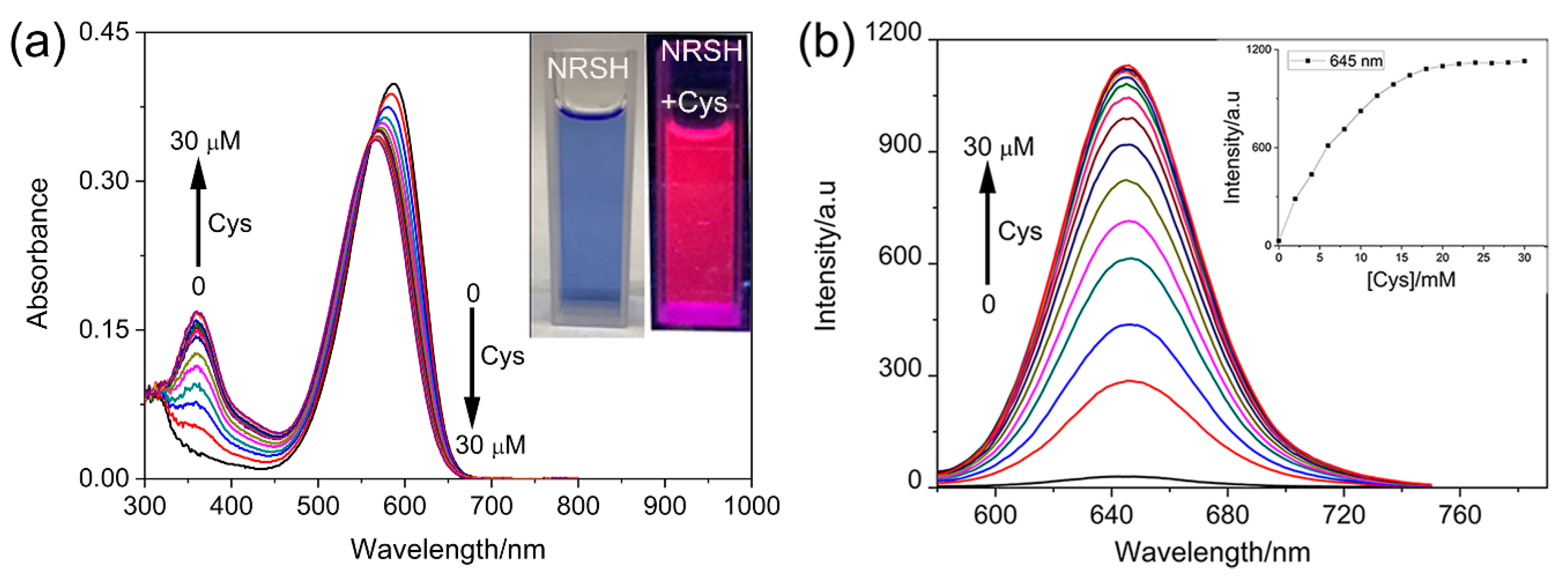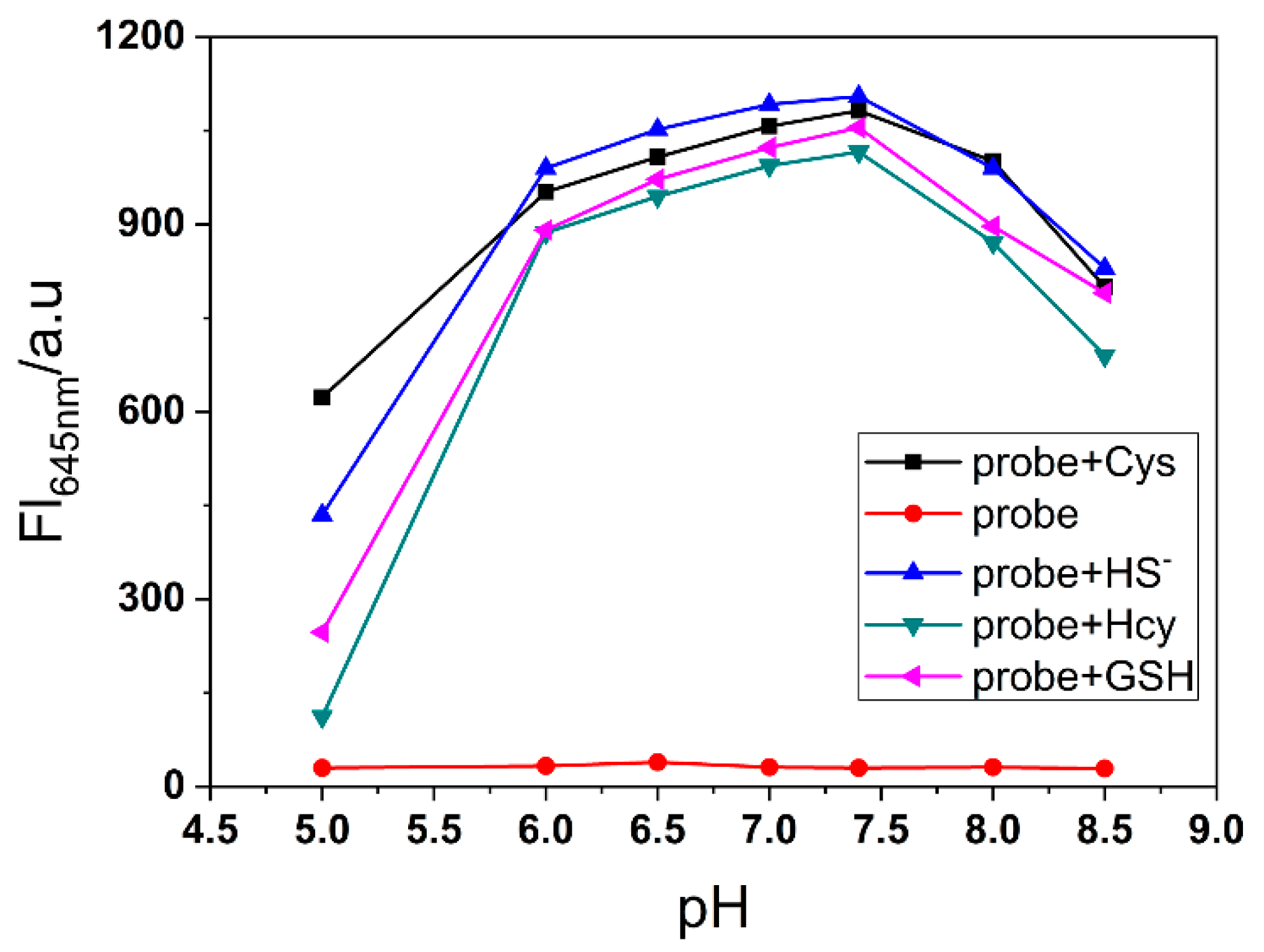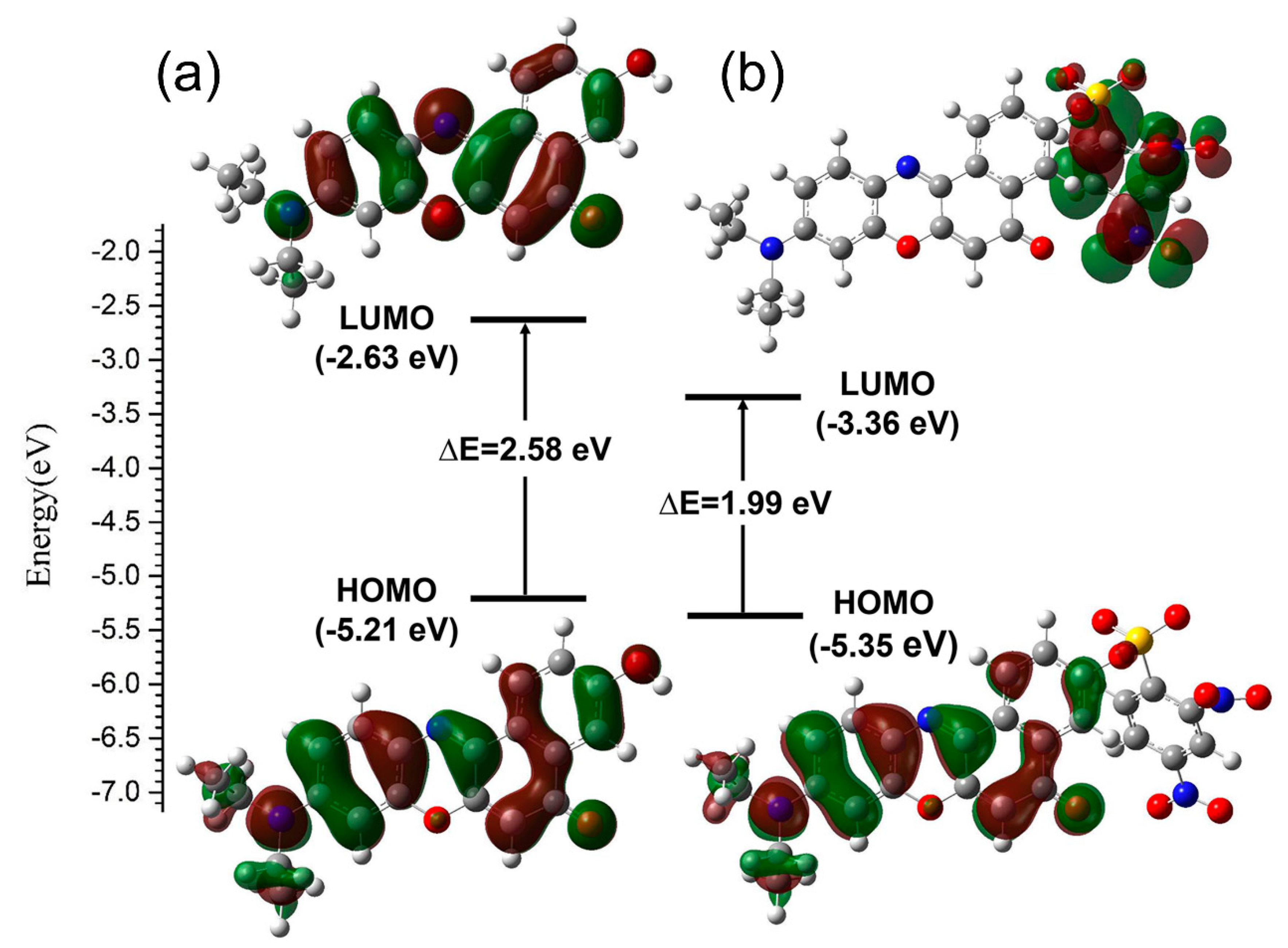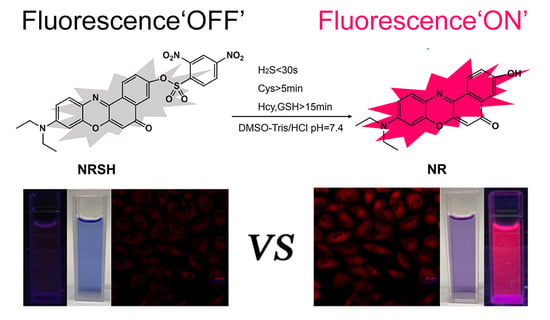Nile-Red-Based Fluorescence Probe for Selective Detection of Biothiols, Computational Study, and Application in Cell Imaging
Abstract
1. Introduction
2. Results and Discussion
2.1. Design of the Probe NRSH
2.2. Optical Properties
2.3. Cell Imaging
2.4. Computational Analysis
3. Experimental
3.1. Materials and Instrumentations
3.2. Synthesis of NRSH
3.3. Measurement Procedures
3.4. Kinetic Studies
3.5. Cell Image Experiment
3.6. Computation Details
4. Conclusions
Supplementary Materials
Author Contributions
Funding
Conflicts of Interest
References
- Li, Y.; Liu, W.; Zhang, P.; Zhang, H.; Wu, J.; Ge, J.; Wang, P. A fluorescent probe for the efficient discrimination of Cys, Hcy and GSH based on different cascade reactions. Biosens. Bioelectron. 2017, 90, 117–124. [Google Scholar] [CrossRef] [PubMed]
- Zhang, H.; Xu, L.; Chen, W.; Huang, J.; Huang, C.; Sheng, J.; Song, X. Simultaneous discrimination of cysteine, homocysteine, glutathione, and H2S in living cells through a multisignal combination strategy. Anal. Chem. 2018, 91, 1904–1911. [Google Scholar] [CrossRef] [PubMed]
- Chao, J.; Li, M.; Liu, Y.; Zhang, Y.; Huo, F.; Yin, C. Fluorescence detection and imaging in zebrafish and Arabidopsis thaliana based on Cys/Hcy breaking space effect. Sens. Actuators B 2019, 298, 126844. [Google Scholar] [CrossRef]
- Kang, J.; Huo, F.; Yao, Y.; Yin, C. A high signal-to-background ratio H2S-specific fluorescent probe based on nucleophilic substitution and its bioimaging for generation H2S induced by Ca2+ in vivo. Dyes Pigm. 2019, 171, 107755. [Google Scholar] [CrossRef]
- Wang, J.; Wen, Y.; Huo, F.; Yin, C. Based ‘successive’ nucleophilic substitution mitochondrial-targeted H2S red light emissive fluorescent probe and its imaging in mice. Sens. Actuators B 2019, 297, 126773. [Google Scholar] [CrossRef]
- Jiao, X.; Li, Y.; Niu, J.; Xie, X.; Wang, X.; Tang, B. Small-molecule fluorescent probes for imaging and detection of reactive oxygen, nitrogen, and sulfur species in biological systems. Anal. Chem. 2017, 90, 533–555. [Google Scholar] [CrossRef]
- Jung, H.S.; Chen, X.; Kim, J.S.; Yoon, J. Recent progress in luminescent and colorimetric chemosensors for detection of thiols. Chem. Soc. Rev. 2013, 42, 6019–6031. [Google Scholar] [CrossRef]
- Lee, S.; Li, J.; Zhou, X.; Yin, J.; Yoon, J. Recent progress on the development of glutathione (GSH) selective fluorescent and colorimetric probes. Coord. Chem. Rev. 2018, 366, 29–68. [Google Scholar] [CrossRef]
- Niu, L.; Chen, Y.; Zheng, H.; Wu, L.; Tung, C.; Yang, Q. Design strategies of fluorescent probes for selective detection among biothiols. Chem. Soc. Rev. 2015, 44, 6143–6160. [Google Scholar] [CrossRef]
- Hong, J.; Feng, W.; Feng, G. Highly selective near-infrared fluorescent probe with rapid response, remarkable large Stokes shift and bright fluorescence for H2S detection in living cells and animals. Sens. Actuators B 2018, 262, 837–844. [Google Scholar] [CrossRef]
- Li, Y.; Wang, K.; Liu, B.; Lu, X.; Li, M.; Ji, L.; Mao, Z. Mitochondria-targeted two-photon fluorescent probe for the detection of biothiols in living cells. Sens. Actuators B 2018, 255, 193–202. [Google Scholar] [CrossRef]
- Sedgwick, A.C.; Gardiner, J.E.; Kim, G.; Yevglevskis, M.; Lloyd, M.D.; Jenkins, A.T.A.; Bull, S.D.; Yoon, J.; James, T.D. Long-wavelength TCF-based fluorescence probes for the detection and intracellular imaging of biological thiols. Chem. Commun. 2018, 54, 4786–4789. [Google Scholar] [CrossRef]
- Wang, L.; Yang, X.F.; Zhao, M. A 4-methylumbelliferone-based fluorescent probe for the sensitive detection of captopril. J. Fluoresc. 2009, 19, 593–599. [Google Scholar] [CrossRef] [PubMed]
- Zhang, S.; Wang, Q.; Liu, X.; Zhang, J.; Yang, X.F.; Li, Z.; Li, H. Sensitive and selective fluorescent probe for selenol in living cells designed via a pKa shift strategy. Anal. Chem. 2018, 90, 4119–4125. [Google Scholar] [CrossRef] [PubMed]
- Bu, L.; Chen, J.; Wei, X.; Li, X.; Ågren, H.; Xie, Y. An AIE and ICT based NIR florescent probe for cysteine and homocysteine. Dyes Pigm. 2017, 136, 724–731. [Google Scholar] [CrossRef]
- Jiang, X.; Zhang, J.; Shao, X.; Zhao, W. A selective fluorescent turn-on NIR probe for cysteine. Org. Biomol. Chem. 2012, 10, 1966–1968. [Google Scholar] [CrossRef] [PubMed]
- Liu, K.; Shang, H.; Kong, X.; Lin, W. A novel near-infrared fluorescent probe with a large Stokes shift for biothiol detection and application in in vitro and in vivo fluorescence imaging. J. Mater. Chem. B 2017, 5, 3836–3841. [Google Scholar] [CrossRef] [PubMed]
- Meng, Y.L.; Xin, Z.H.; Jia, Y.J.; Kang, Y.F.; Ge, L.P.; Zhang, C.H.; Dai, M.Y. A near-infrared fluorescent probe for direct and selective detection of cysteine over homocysteine and glutathione. Spectrochim. Acta Part A 2018, 202, 301–304. [Google Scholar] [CrossRef]
- Zhang, X.; Liu, J.; Ma, W.; Yang, M. Near-infrared fluorescence of π-conjugation extended benzothiazole and its application for biothiol imaging in living cells. J. Mater. Chem. B 2016, 4, 6662–6669. [Google Scholar] [CrossRef]
- Black, S.L.; Stanley, W.A.; Filipp, F.V.; Bhairo, M.; Verma, A.; Wichmann, O.; Sattler, M.; Wilmanns, M.; Schultz, C. Probing lipid- and drug-binding domains with fluorescent dyes. Biorg. Med. Chem. 2008, 16, 1162–1173. [Google Scholar] [CrossRef]
- Fan, J.; Guo, S.; Wang, S.; Kang, Y.; Yao, Q.; Wang, J.; Gao, X.; Wang, H.; Du, J.; Peng, X. Lighting-up breast cancer cells by a near-infrared fluorescent probe based on KIAA1363 enzyme-targeting. Chem. Commun. Camb. 2017, 53, 4857–4860. [Google Scholar] [CrossRef] [PubMed]
- Jiang, X.; Guan, J.; Bian, H.; Xiao, Y. A cinnamoyl substituted Nile Red-based probe to detect hydrazine. Tetrahedron Lett. 2017, 58, 2351–2354. [Google Scholar] [CrossRef]
- Kong, X.; Dong, B.; Zhang, N.; Wang, C.; Song, X.; Lin, W. A unique red-emitting two-photon fluorescent probe with tumor-specificity for imaging in living cells and tissues. Talanta 2017, 174, 357–364. [Google Scholar] [CrossRef] [PubMed]
- Li, K.; Chen, F.; Zhang, S.; Shi, W.; Han, D.; Cai, C.; Chen, C.X. A nile red-based near-infrared fluorescent probe for endogenous hydrogen polysulfides in living cells. Anal. Methods 2017, 9, 6443–6447. [Google Scholar] [CrossRef]
- Park, S.; Kubota, Y.; Funabiki, K.; Shiro, M.; Matsui, M. Near-infrared solid-state fluorescent naphthooxazine dyes attached with bulky dibutylamino and perfluoroalkenyloxy groups at 6- and 9-positions. Tetrahedron Lett. 2009, 50, 1131–1135. [Google Scholar] [CrossRef]
- Rostron, K.A.; Lawrence, C.L. Nile Red Staining of Neutral Lipids in Yeast. Methods Mol. Biol. 2017, 1560, 219–229. [Google Scholar] [PubMed]
- Takeshita, T.; Takeda, K.; Ota, S.; Yamazaki, T.; Kawano, S. A Simple Method for Measuring the Starch and Lipid Contents in the Cell of Microalgae. Cytologia 2015, 80, 475–481. [Google Scholar] [CrossRef]
- Wichmann, O.; Gelb, M.H.; Schultz, C. Probing phospholipase A2 with fluorescent phospholipid substrates. ChemBioChem 2007, 8, 1555–1569. [Google Scholar] [CrossRef]
- Jiang, X.; Yu, H.; Zhao, J.; Sun, C.; Xie, Y.; Xiao, L. A colorimetric chemosensor based on new water-soluble PODIPY dye for Hg2+ detection. Chin. Chem. Lett. 2015, 26, 1241–1245. [Google Scholar] [CrossRef]
- Lee, J.; Lee, Y.J.; Ahn, Y.J.; Choi, S.; Lee, G.J. A simple and facile paper-based colorimetric assay for detection of free hydrogen sulfide in prostate cancer cells. Sens. Actuators B 2018, 256, 828–834. [Google Scholar] [CrossRef]
- Murugesan, K.; Jeyasingh, V.; Lakshminarayanan, S.; Govindaraj, T.S.; Paulraj, M.S.; Narayanan, S.; Piramuthu, L. Electron-deficient tripodal amide based receptor: An exclusive turn-on fluorescent and colorimetric chemo sensor for cyanide ion. Spectrochim. Acta Part A 2018, 198, 309–314. [Google Scholar] [CrossRef] [PubMed]
- Tsumura, S.; Enoki, T.; Ooyama, Y. A colorimetric and fluorescent sensor for water in acetonitrile based on intramolecular charge transfer: D-(π-A)2-type pyridine-boron trifluoride complex. Chem. Commun. Camb. 2018, 54, 10144–10147. [Google Scholar] [CrossRef] [PubMed]
- Wang, L.; Zhuo, S.; Cao, D. A colorimetric and fluorescent probe based on michael acceptor type diketopyrrolopyrrole for cyanide detection. J. Fluoresc. 2017, 27, 1587–1594. [Google Scholar] [CrossRef] [PubMed]
- Yang, Z.; Fu, K.; Yu, J.; Zhou, P.; Cheng, Z. A colorimetric and fluorescent indicator for Hg2+ detection based on cinnamamide group-containing rhodamine derivative. J. Fluoresc. 2018, 28, 905–911. [Google Scholar] [CrossRef]
- Zhang, J.; Peng, A.; Lv, Y.; Zhang, Y.; Wang, X.; Zhang, G.; Tian, Z. A colorimetric fluorescent probe for SO2 derivatives-bisulfite and sulfite at nanomolar level. J. Fluoresc. 2017, 27, 1767–1775. [Google Scholar] [CrossRef]
- Feng, S.; Fang, Y.; Feng, W.; Xia, Q.; Feng, G. A colorimetric and ratiometric fluorescent probe with enhanced near-infrared fluorescence for selective detection of cysteine and its application in living cells. Dyes Pigm. 2017, 146, 103–111. [Google Scholar] [CrossRef]
- Qi, S.; Liu, W.; Zhang, P.; Wu, J.; Zhang, H.; Ren, H.; Ge, J.; Wang, P. A colorimetric and ratiometric fluorescent probe for highly selective detection of glutathione in the mitochondria of living cells. Sens. Actuators B 2018, 270, 459–465. [Google Scholar] [CrossRef]
- Wang, Y.; Zhu, M.; Jiang, E.; Hua, R.; Na, R.; Li, Q.X. A simple and rapid turn on ESIPT fluorescent probe for colorimetric and ratiometric detection of biothiols in living cells. Sci. Rep. 2017, 7, 4377. [Google Scholar] [CrossRef]
- Zhang, X.; Yan, Y.; Hang, Y.; Wang, J.; Hua, J.; Tian, H. A phenazine-barbituric acid based colorimetric and ratiometric near-infrared fluorescent probe for sensitively differentiating biothiols and its application in TiO2 sensor devices. Chem. Commun. 2017, 53, 5760–5763. [Google Scholar] [CrossRef]
- Zhao, B.; Yang, B.; Hu, X.; Liu, B. Two colorimetric and ratiometric fluorescence probes for hydrogen sulfide based on AIE strategy of alpha-cyanostilbenes. Spectrochim. Acta Part A 2018, 199, 117–122. [Google Scholar] [CrossRef]
- Liu, X.D.; Fan, C.; Sun, R.; Xu, Y.J.; Ge, J.F. Nile-red and Nile-blue-based near-infrared fluorescent probes for in-cellulo imaging of hydrogen sulfide. Anal. Bioanal. Chem. 2014, 406, 7059–7070. [Google Scholar] [CrossRef] [PubMed]
- Lu, J.; Song, Y.; Shi, W.; Li, X.; Ma, H. A long-wavelength fluorescent probe for imaging reduced glutathione in live cells. Sens. Actuators B 2012, 161, 615–620. [Google Scholar] [CrossRef]
- Tang, C.; Zheng, Q.; Zong, S.; Wang, Z.; Cui, Y. A long-wavelength-emitting fluorescent turn-on probe for imaging hydrogen sulfide in living cells. Sens. Actuators B 2014, 202, 99–104. [Google Scholar] [CrossRef]
- Yang, X.Z.; Wei, X.R.; Sun, R.; Xu, Y.J.; Ge, J.F. Benzoxazine-based fluorescent probes with different auxochrome groups for cysteine detection. Spectrochim. Acta Part A 2020, 226, 117582. [Google Scholar] [CrossRef] [PubMed]
- Niu, H.; Ni, B.; Chen, K.; Yang, X.; Cao, W.; Ye, Y.; Zhao, Y. A long-wavelength-emitting fluorescent probe for simultaneous discrimination of H2S/Cys/GSH and its bio-imaging applications. Talanta 2019, 196, 145–152. [Google Scholar] [CrossRef]
- Lan, J.S.; Zeng, R.F.; Liu, Y.; Xiang, Y.W.; Jiang, X.Y.; Liu, L.; Xie, S.S.; Ding, Y.; Zhang, T. A near-infrared Nile red fluorescent probe for the discrimination of biothiols by dual-channel response and its bioimaging applications in living cells and animals. Analyst 2019, 144, 3676–3684. [Google Scholar] [CrossRef]
- Sarkar, N.; Das, K.; Nath, D.N.; Bhattacharyya, K. Twisted charge transfer processes of Nile red in homogeneous solutions and in faujasite zeolite. Langmuir 1994, 10, 326–329. [Google Scholar] [CrossRef]
- Datta, A.; Mandal, D.; Pal, S.K.; Bhattacharyya, K. Intramolecular Charge Transfer Processes in Confined Systems. Nile Red in Reverse Micelles. J. Phys. Chem. B 1997, 101, 10221–10225. [Google Scholar] [CrossRef]
- Krishna, M.M.G. Excited-State Kinetics of the Hydrophobic Probe Nile Red in Membranes and Micelles. J. Phys. Chem. A 1999, 103, 3589–3595. [Google Scholar] [CrossRef]
- Hazra, P.; Chakrabarty, D.; Chakraborty, A.; Sarkar, N. Intramolecular charge transfer and solvation dynamics of Nile Red in the nanocavity of cyclodextrins. Chem. Phys. Lett. 2004, 388, 150–157. [Google Scholar] [CrossRef]
- Mei, Q.; Shi, Y.; Hua, Q.; Tong, B. Phosphorescent chemosensor for Hg2+ based on an iridium(iii) complex coordinated with 4-phenylquinazoline and carbazole dithiocarbamate. RSC Adv. 2015, 5, 74924–74931. [Google Scholar] [CrossRef]
- Klán, P.; Wirz, J. Photochemistry of Organic Compounds: From Concepts to Practice; John Wiley & Sons: Hoboken, NJ, USA, 2009; p. 40. [Google Scholar]
- Lu, T.; Chen, F. Multiwfn: A multifunctional wavefunction analyzer. J. Comput. Chem. 2012, 33, 580–592. [Google Scholar] [CrossRef] [PubMed]
- Liu, Z.; Lu, T.; Chen, Q. An sp-hybridized all-carboatomic ring, cyclo [18] carbon: Electronic structure, electronic spectrum, and optical nonlinearity. Carbon 2020, 165, 461–467. [Google Scholar] [CrossRef]
- Marenich, A.V.; Cramer, C.J.; Truhlar, D.G. Universal Solvation Model Based on Solute Electron Density and on a Continuum Model of the Solvent Defined by the Bulk Dielectric Constant and Atomic Surface Tensions. J. Phys. Chem. B 2009, 113, 6378–6396. [Google Scholar] [CrossRef]
- Frisch, M.J.; Trucks, G.W.; Schlegel, H.B.; Scuseria, G.E.; Robb, M.A.; Cheeseman, J.R.; Scalmani, G.; Barone, V.; Mennucci, B.; Petersson, G.A.; et al. Gaussian 09, Revision, B.01; Gaussian, Inc.: Wallingford, CT, USA, 2010. [Google Scholar]
Sample Availability: Samples of the compounds are not available from the authors. |










| Probe | Transition | Experiment (nm, eV) | Calculated (nm, eV) | f | % |
|---|---|---|---|---|---|
| NR | HOMO→LUMO | 645, 1.92 | 622, 1.99 | 1.2064 | 100 |
| NRSH | HOMO→LUMO | – | 1381, 0.90 | 0.0001 | 100 |
| NR | NRSH | |
|---|---|---|
| 1 | −0.22455 | −0.24376 |
| 2 | 0.24355 | −0.74615 |
| 3 | −0.01900 | 0.98991 |
| NR | NRSH | |
|---|---|---|
| 1→2 | 0.22362 | 0.00092 |
| 1→3 | 0.00093 | 0.24284 |
| 2→3 | −0.01993 | 0.74707 |
Publisher’s Note: MDPI stays neutral with regard to jurisdictional claims in published maps and institutional affiliations. |
© 2020 by the authors. Licensee MDPI, Basel, Switzerland. This article is an open access article distributed under the terms and conditions of the Creative Commons Attribution (CC BY) license (http://creativecommons.org/licenses/by/4.0/).
Share and Cite
Rong, X.; Xu, Z.-Y.; Yan, J.-W.; Meng, Z.-Z.; Zhu, B.; Zhang, L. Nile-Red-Based Fluorescence Probe for Selective Detection of Biothiols, Computational Study, and Application in Cell Imaging. Molecules 2020, 25, 4718. https://doi.org/10.3390/molecules25204718
Rong X, Xu Z-Y, Yan J-W, Meng Z-Z, Zhu B, Zhang L. Nile-Red-Based Fluorescence Probe for Selective Detection of Biothiols, Computational Study, and Application in Cell Imaging. Molecules. 2020; 25(20):4718. https://doi.org/10.3390/molecules25204718
Chicago/Turabian StyleRong, Xiang, Zhong-Yong Xu, Jin-Wu Yan, Zhi-Zhong Meng, Bin Zhu, and Lei Zhang. 2020. "Nile-Red-Based Fluorescence Probe for Selective Detection of Biothiols, Computational Study, and Application in Cell Imaging" Molecules 25, no. 20: 4718. https://doi.org/10.3390/molecules25204718
APA StyleRong, X., Xu, Z.-Y., Yan, J.-W., Meng, Z.-Z., Zhu, B., & Zhang, L. (2020). Nile-Red-Based Fluorescence Probe for Selective Detection of Biothiols, Computational Study, and Application in Cell Imaging. Molecules, 25(20), 4718. https://doi.org/10.3390/molecules25204718








